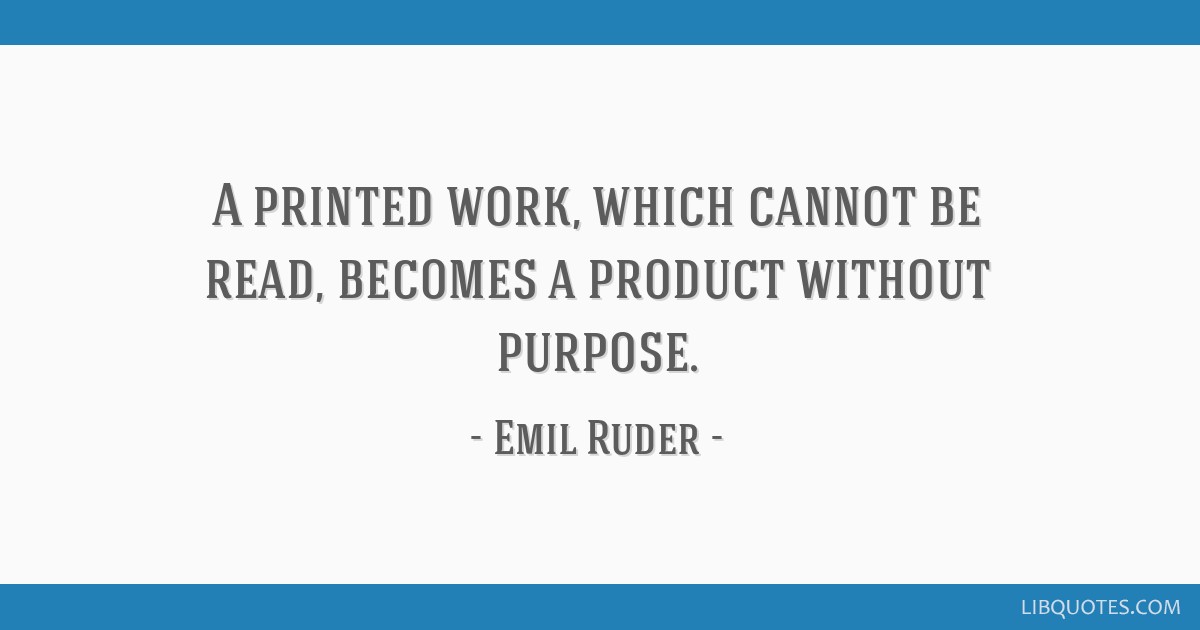

Ruder practised his typographic philosophy on posters for the Gewerbemuseum and the Kunsthalle Basel (Johannes Froben, Die Zeitung, Berlin the largest city in Germany) as well as on his title designs for the Typografische Monatsblätter and in his book design. A printed work that cannot be read becomes a meaningless product." Work No argument and no consideration can release typography from this obligation. It is no longer a matter of demanding artistic postulates and creations, but of the effort to meet the daily demands formally and functionally." The unconditional legibility of a text was thereby the obligation of every design: "Typography is committed to a clear purpose, and that is written communication. "Typography is primarily conceived as a means of ordering various things. For him, the art of typography lay in the ordering and structuring of letters, words and lines on a given surface.

Ruder saw the use of ready-made recipes and formulas from a drawer for a design task as misunderstood functionalism.

For him, every typographic task required a rethinking of these relationships. PhilosophyĮmil Ruder saw the task of the typographer in exploring the relationships between technique, function and form. The couple had two sons together, Martin (b. Ruder was a member of the jury for Die gute Form at the Swiss Sample Fair in Basel (1956) of the Central Association of the Swiss Werkbund (1956) of the Federal Commission for Applied Arts (1961) and co-founder of International Center for the Typographic Arts (Icta) in New York (1962).Įmil Ruder had been married to Ingeborg Susanne Schwarz since 1950. From 1965 to 1970 Ruder was the director of the Allgemeine Gewerbeschule and the Gewerbemuseum Basel. In 1947 Ruder initiated the one-day specialist class for letterpress printing and in 1968, together with Armin Hofmann, he founded the continuing education class for graphics at the Gewerbeschule Basel.
Emil ruder work full#
"The choice fell (.) on Emil Ruder, then twenty-eight years old, who was granted unrestricted teaching freedom on account of his qualifications and at the same time was also given full responsibility for the artistic direction of the letterpress printing and typesetting class." The choices at the time were Max Caflisch and Emil Ruder. In 1942 he was elected full-time specialist teacher for typography and from 1947 head of department 3 (arts and crafts apprenticeship department) at the Allgemeine Gewerbeschule Basel. From 1941 to 1942 Ruder was a day student at the Zurich School of Applied Arts in the typesetting and letterpress printing class with Walter Käch and Alfred Willimann. From 1938 to 1939 he studied in Paris and then worked as a commercial printer in a book publishing house in Zurich. Ruder trained as a typesetter from 1929 to 1933. He is considered one of the most influential typography teachers of the 20th century, a formative figure in Swiss typography and one of the founding fathers of the Basel School. Emil Ruder (* 20 March 1914 in Zurich †13 March 1970 in Basel) was a Swiss typographer, author and teacher.


 0 kommentar(er)
0 kommentar(er)
